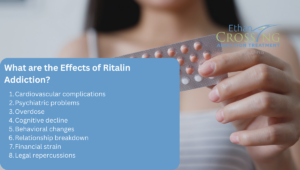Ritalin, a prescribed medication utilized for managing attention deficit hyperactivity disorder (ADHD) symptoms, is a well-known brand name for methylphenidate, categorized under stimulant drugs. Given the stimulating nature of this drug class, it’s natural to question its potential for addiction.
Indications of Ritalin dependency involve strong cravings for the medication, surpassing prescribed dosages, significant contemplation about Ritalin, devising means to obtain it, persisting in its use despite adverse health effects, and encountering withdrawal symptoms when reducing or ceasing Ritalin intake.
According to the Centers for Disease Control and Prevention, 10.2% percent of American children between the ages of 3-17 years have been diagnosed with ADHD. it is no surprise then that the United States Drug Enforcement Administration reports that most Ritalin misuse is among people younger than 25 years old who obtain Ritalin from a friend. Between 2020 and 2021, approximately 536,000 people, or 0.2% of the population in the United States from 12 and older misused Ritalin, according to the National Survey of Drug Use and Health (NSDUH).
The consequences of Ritalin addiction encompass reduced appetite, heightened anxiety, altered heart rate, elevated blood pressure, insomnia, fatigue, nervousness, panic attacks, and depression.
Table of Contents
What is Ritalin?
Ritalin is the brand name for the drug Methylphenidate. It functions as a central nervous system (CNS) stimulant often prescribed for Attention Deficit Hyperactivity Disorder (ADHD) and, occasionally, narcolepsy. Its primary purpose is to enhance focus, and attention, and address behavioral issues associated with ADHD.
Ritalin exerts its impact by influencing specific neurotransmitters in the brain, particularly dopamine and norepinephrine. This process is vital, as dopamine plays a crucial role in motivation, pleasure, and reward, while norepinephrine influences attention and response actions in the brain.
Through the elevation of these neurotransmitter levels, Ritalin augments neural signaling and communication, leading to improved attention and focus in individuals with ADHD. Additionally, it aids in reducing excessive daytime sleepiness in those diagnosed with narcolepsy. Being a stimulant has the potential for addiction. It is therefore listed as a Schedule II substance under the Controlled Substances Act (CSA).
What is Ritalin Addiction?
Ritalin addiction occurs when an individual has a compulsive and uncontrollable use of Ritalin despite its negative consequences on an individual’s physical and mental health, relationships, and overall well-being.
Ritalin is not physically addictive in the same way as substances like opioids. Instead, continuous use leads to psychological dependence, where individuals experience intense cravings and withdrawal symptoms when they stop using it, even if they don’t experience the typical physical withdrawal symptoms associated with other addictive substances.
What are the Symptoms of Ritalin Addiction?
Recognizing the symptoms of Ritalin addiction is crucial, especially for parents aiming to prevent misuse among their children. The indicators of Ritalin addiction encompass the following:
Intense Cravings and Urges to Take Ritalin
Prolonged use of Ritalin elevates dopamine levels in the brain, creating an association between pleasurable feelings and the substance. As a result, individuals may experience intense cravings and urges to consume Ritalin, impacting their thoughts, emotions, and decision-making.
Taking Larger Amounts Than Prescribed
Those developing an addiction to Ritalin often find themselves taking larger quantities of the medication than initially prescribed. This escalation is driven by the desire to replicate the stimulant effects initially felt, indicating a progression toward dependency.
Preoccupation with Ritalin
Ritalin abuse leads to a significant amount of time spent thinking about the drug, strategizing ways to acquire it, and recovering from its effects. The individual’s life may become centered around Ritalin use, potentially leading to extreme measures such as theft or selling belongings to fund the habit.
Continued Use Despite Negative Health Effects
Addiction is characterized by compulsive drug-seeking behavior despite negative impacts on physical and mental health. The functional changes in the brain caused by addiction result in a lack of self-control, leading individuals to persist in Ritalin use despite its detrimental effects.
Withdrawal Symptoms upon Reduction or Cessation
Abruptly or gradually reducing Ritalin use triggers withdrawal symptoms as the body struggles to adapt to the absence of the substance. These withdrawal symptoms contribute significantly to the perpetuation of the addiction cycle, making it challenging for individuals with substance use disorders to break free.
What are the Causes of Ritalin Addiction?
Ritalin addiction, unlike many other issues, doesn’t have a single, clear-cut cause. Instead, it arises from a complex interplay of various factors that contribute to and increase an individual’s risk. Understanding these factors is crucial in preventing and addressing Ritalin misuse.
- Genetic predisposition: Studies suggest that as much as half of a person’s vulnerability to prescription drug addiction, including Ritalin, may be linked to their genes. This doesn’t guarantee addiction, but it highlights the potential role of family history in influencing risk.
- Underlying conditions: While Ritalin is used to treat ADHD and, to a lesser extent, narcolepsy, having either condition might increase someone’s risk of developing an addiction. This can stem from self-medication attempts, seeking to alleviate symptoms independently without proper medical guidance.
- Peer pressure and social influences: Ritalin, unfortunately, has the street name “kiddie cocaine,” reflecting its growing misuse as a party drug. This, coupled with the misconception of “coolness” associated with such behavior in certain social circles, can significantly impact young people, pressuring them to experiment with the drug.
- Easy accessibility: The ease of access to Ritalin plays a major role. Prescription drugs, often readily available within families or through friends, can be diverted for recreational use. Additionally, the illegal sale of these medications further fuels the issue, highlighting the importance of responsible medication storage and disposal.
- Lack of knowledge: Effective drug education, particularly targeted towards young people, is critical. Misconceptions and a lack of awareness about the dangers of prescription drug misuse can easily lead individuals down a path of addiction. By providing accurate and comprehensive information, we can empower individuals to make informed and responsible choices regarding their health and well-being.
Understanding these contributing factors is just the first step. By addressing them through comprehensive education, responsible medication management practices, and addressing underlying conditions, we can work towards reducing the risk of Ritalin addiction and promoting safer and healthier communities.
What are the Effects of Ritalin Addiction?
While Ritalin offers potential benefits for those with ADHD, misusing it can lead to a range of serious health problems, some even life-threatening. Beyond common side effects like increased heart rate and insomnia, chronic misuse can cause lasting damage:
- Cardiovascular complications: Ritalin elevates heart rate and blood pressure. For individuals with pre-existing heart conditions, this can significantly increase the risk of serious events like stroke, heart attack, or even sudden death, especially at high doses.
- Psychiatric problems: Misusing Ritalin can trigger or worsen mental health issues, leading to anxiety, paranoia, psychosis, and even thoughts of self-harm or harming others.
- Overdose: Taking Ritalin beyond prescribed doses or mixing it with other substances can lead to overdose. Symptoms can range from agitation and restlessness to heart irregularities, seizures, and even death.
- Cognitive decline: Over time, Ritalin abuse can take a toll on your cognitive abilities, affecting memory, attention span, and decision-making skills, hindering your daily functioning.
- Behavioral changes: Addiction can lead to risky behaviors, neglecting responsibilities, and social withdrawal, causing strain on personal and professional relationships.
- Relationship breakdown: Trust issues, communication problems, and isolation often arise due to addiction, jeopardizing personal connections with family and friends.
- Financial strain: Supporting a Ritalin addiction can be financially draining, leading to debt and impacting your financial stability.
- Legal repercussions: Possessing or using Ritalin without a prescription is illegal and can result in serious legal consequences, including criminal charges and a lasting criminal record.
It’s crucial to remember that Ritalin, like all medications, should only be used as prescribed by a healthcare professional. If you or someone you know is struggling with Ritalin addiction, seeking professional help is crucial to manage withdrawal symptoms and address underlying issues in a safe and supportive environment.
What are the Treatment Approaches for Ritalin?
Overcoming Ritalin addiction, like any addiction, requires a comprehensive approach tailored to the individual’s needs. Fortunately, various treatments are available to guide you towards recovery and a healthier life.
1. Medically Supervised Detox
The journey often begins with medically supervised detoxification, a crucial first step. Under the watchful eye of medical professionals, your body safely eliminates the remaining Ritalin from your system. This process can be physically and emotionally challenging, with withdrawal symptoms ranging from headaches and nausea to anxiety and depression. Medical supervision ensures these symptoms are managed safely and effectively, reducing the risk of relapse.
2. Behavioral Therapy
Detoxification is just the beginning. Long-lasting recovery requires addressing the underlying thoughts and behaviors that might have contributed to Ritalin misuse. Here, behavioral therapy, particularly Cognitive Behavioral Therapy (CBT), plays a vital role. In CBT sessions, you’ll work alongside a mental health professional to identify and modify negative thought patterns and behaviors associated with Ritalin use. This empowers you to develop healthier coping mechanisms and prevent future relapses.
3. Support Groups
The road to recovery doesn’t have to be walked alone. 12-step programs like Narcotics Anonymous can provide invaluable support through shared experiences and a sense of community. Connecting with individuals who understand your struggles can offer encouragement, motivation, and accountability throughout your recovery journey.
4. Medication-Assisted Treatment (MAT)
While the FDA hasn’t specifically approved any medications for treating Ritalin addiction, healthcare professionals may use certain medications to manage withdrawal symptoms, such as antidepressants or anxiolytics, to alleviate discomfort and improve your overall well-being during the recovery process.
Can i get Addicted to Medications Like Ketamine?
ketamine has the potential for addiction, particularly when used recreationally or in high doses. Ketamine is classified as a dissociative anesthetic and is known for its hallucinogenic and sedative effects. While it is primarily used for medical purposes, such as anesthesia and pain management, it is also abused for its psychoactive properties.
Several factors contribute to the addictive potential of ketamine:
- Psychological Dependence: Ketamine can produce euphoria, dissociation, and altered perceptions of reality, which some individuals may find pleasurable or addictive. The desire to experience these effects again can lead to repeated use and the development of psychological dependence.
- Tolerance: With repeated use, individuals may develop tolerance to the effects of ketamine, requiring higher doses to achieve the desired effects. This can increase the risk of dependence and addiction as users escalate their intake to maintain the desired high.
Is Ritalin addictive if taken as prescribed?
The risk of addiction is significantly lower when taking Ritalin exactly as prescribed by a doctor for ADHD or narcolepsy. However, it’s crucial to follow your doctor’s instructions and not misuse the medication.
Can you recover from Ritalin addiction?
Yes, recovery is possible with the right support and treatment plan. Seeking professional help from a qualified healthcare provider or addiction specialist is crucial for creating a personalized treatment plan and achieving long-term recovery.
How long does it take to recover from Ritalin addiction?
There is no one-size-fits-all answer, as the recovery timeline varies for each individual. It depends on factors like the severity of the addiction and the individual’s commitment to treatment.
Is it safe to use Ritalin again after recovering from addiction?
This is a question best discussed with your doctor. They can assess your situation and determine if it’s safe to resume Ritalin use, potentially at a lower dosage or alternative medication altogether.
What if I’m concerned about someone else struggling with Ritalin addiction?
Openly communicate your concerns and offer support. Encourage them to seek professional help and offer to accompany them to appointments. Remember, you can’t force someone to get help, but you can be a source of support and encouragement.












